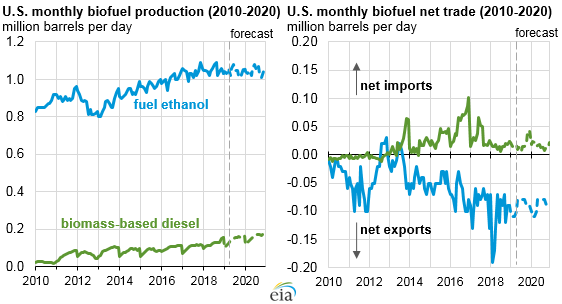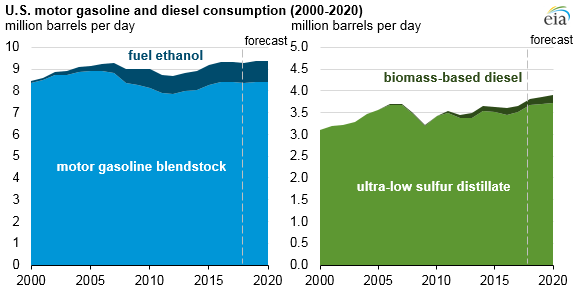In its February 2019 Short-Term Energy Outlook (STEO), EIA forecasts that several recent trends in U.S. biofuels markets will continue through 2020. In the STEO, production of fuel ethanol and net imports of biomass-based diesel stay unchanged, while net exports of fuel ethanol decline modestly. Federal mandates and state programs continue to support biofuel consumption through 2020, however, biofuels remain a relatively small share of total U.S. liquid transportation fuels supply.

The most common biofuels consumed both domestically and globally are fuel ethanol and biomass-based diesel. Fuel ethanol is primarily blended with motor gasoline blendstock in the United States to produce 10% ethanol blended motor gasoline, or E10. Biomass-based diesel, which collectively refers to biodiesel and renewable diesel, is typically mixed with ultra-low sulfur distillate fuel at varying percentages.
EIA expects that U.S. fuel ethanol production will remain near current levels, decreasing slightly in 2019 to 1.04 million b/d and increasing to 1.05 million b/d in 2020. Fuel ethanol production is largely dependent on domestic motor gasoline consumption, which has been relatively stable in recent years, as fuel economy improvements have largely offset increases in population and vehicle miles traveled.
U.S. ethanol exports have accounted for an increasing share of production since 2013 and have contributed to market growth. EIA forecasts net ethanol exports, which reached nearly 110,000 b/d in 2018, will fall to an average of 90,000 b/d in 2019 and 2020, driven primarily by the expectation that record levels of ethanol exports to Brazil in early 2018 will not persist.
Biomass-based diesel production—excluding renewable diesel—was about 120,000 b/d in 2018 and grows to 160,000 b/d in 2020. Total biomass-based diesel consumption will increase from an estimated 134,000 b/d in 2018 to 174,000 b/d in 2020. Growth in domestic production will continue to be supported by antidumping and countervailing duties placed on biodiesel imports from Argentina and Indonesia that went into effect in 2017. Current import restrictions on these countries will contribute to flat biomass-based diesel net imports through 2020, with U.S. biomass-based diesel net imports about 70% lower than the 2016 peak.
Biofuels account for a relatively small share of total transportation fuels, with consumption supported over time by the federal Renewable Fuel Standard as well as state-level biofuel programs. U.S. consumption of motor gasoline was 9.31 million b/d in 2018, and EIA expects that it will increase by less than 1% annually to 9.36 million b/d by 2020.
Of the motor gasoline demand in 2020, domestic ethanol consumption will contribute about 950,000 b/d, corresponding to a national-level blend rate estimate of 10.2%. Limited demand and ongoing regulatory and infrastructure hurdles for ethanol blends higher than E10 (e.g., E15, E85) and lower-priced petroleum blendstocks restrict higher domestic ethanol consumption rates.

U.S. diesel fuel consumption, which includes biomass-based diesel, is expected to increase from 3.8 million b/d to 3.9 million b/d between 2018 and 2020 in the STEO. The share of biomass-based diesel in diesel fuel increases from 3.6% in 2018 to 4.5% in 2020. Demand for renewable diesel, which includes stand-alone production facilities as well as petroleum refiners that co-process renewable feedstocks in downstream units such as hydrotreaters, is expected to grow in 2020.
Principal contributors: Steve Hanson, Sean Hill

Follow us on social media: